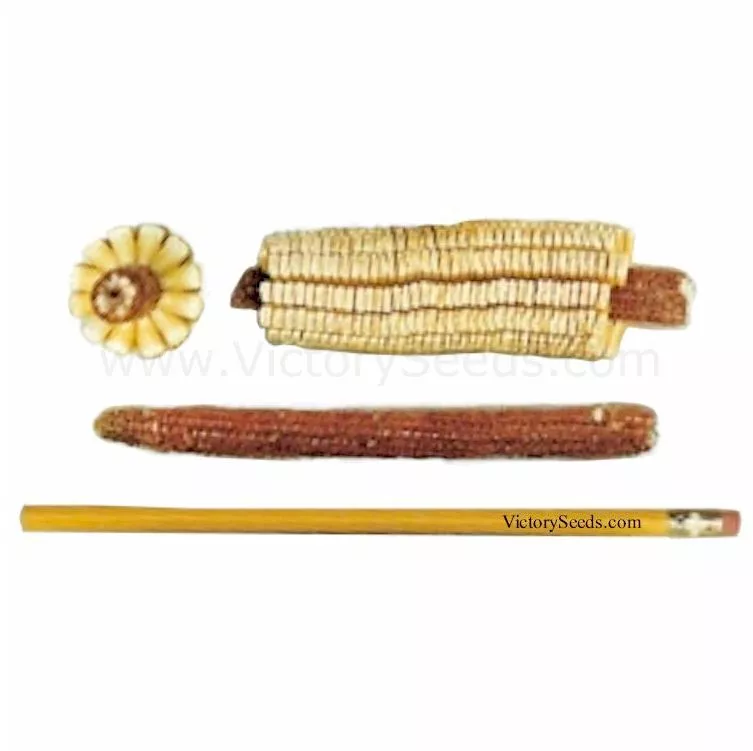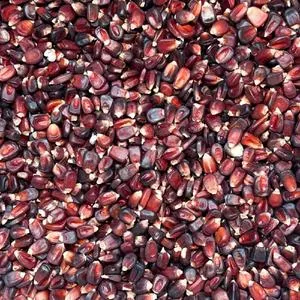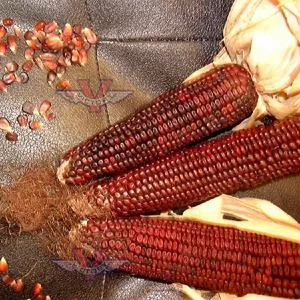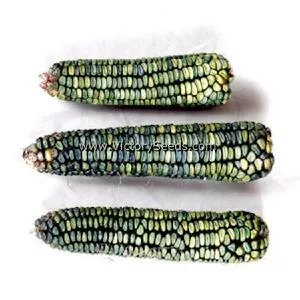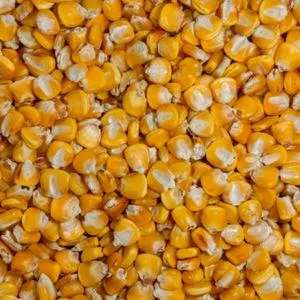Pencil Cob Dent Corn
Zea mays subsp. mays
Price: $3.33
SKU: 31401811Choose a variant:
75 to 100 days - Although now relatively rare, this old "shoe peg type" dent corn variety is an heirloom variety from the Southern United Stated that pre-dates 1900. 'Pencil Cob' is a very flavorful roasting ear corn variety, or picked in its early milk stage at about 75 days, it is used for frying or creaming. Since most field corn varieties have low sugar content, try adding a little sugar when creaming. 'Pencil Cob' is also useful as wildlife and livestock feed.
The plants grow five to six feet tall and produce two to three ears per stalk. As seen in the picture, it gets its name from the fact that the cobs are not much bigger in diameter than a pencil. Although most merchants simply state that it is a white corn, the color of the kernels are actually a dull or drab white color with a yellowish hue, and tips that pick up a reddish tinge from the cob's coloring. 'Pencil Cob' withstands dry weather spells well.
The plants grow five to six feet tall and produce two to three ears per stalk. As seen in the picture, it gets its name from the fact that the cobs are not much bigger in diameter than a pencil. Although most merchants simply state that it is a white corn, the color of the kernels are actually a dull or drab white color with a yellowish hue, and tips that pick up a reddish tinge from the cob's coloring. 'Pencil Cob' withstands dry weather spells well.
Genetic Classification: Open Pollinated
Planting Instructions:
Soil must be at least 65ºF to germinate. Be patient and do not plant too early or you will waste a lot of seed! Plant in full sun and keep it watered. Corn is a wind-pollinated plant. Plant in blocks several rows wide to ensure full ears.
Sow seeds about 1½ to 2½ inch deep, 3 to 4 inches apart, in rows spaced 24 to 30 inches apart. Thin to 6 to 12 inches apart.
Harvest Information:
Pick the ears for dry grain or decoration when the husks are dry and the kernels are hard enough that you cannot make a dent in them with your fingernail. Many people pick the ears too early when kernels are still soft. If this is done they shrivel up and shrink and their beauty is destroyed. They cannot finish maturing once they have been picked.
Even though the ears look dry, there remains moisture deep within the cob. If you were to enclose them in a box, the moisture would cause them to sour and mold. You may let them dry longer on the plants if neither weather nor predators are damaging them. Otherwise hang them up or lay them out in the open until they are completely dry inside.
Sow seeds about 1½ to 2½ inch deep, 3 to 4 inches apart, in rows spaced 24 to 30 inches apart. Thin to 6 to 12 inches apart.
Harvest Information:
Pick the ears for dry grain or decoration when the husks are dry and the kernels are hard enough that you cannot make a dent in them with your fingernail. Many people pick the ears too early when kernels are still soft. If this is done they shrivel up and shrink and their beauty is destroyed. They cannot finish maturing once they have been picked.
Even though the ears look dry, there remains moisture deep within the cob. If you were to enclose them in a box, the moisture would cause them to sour and mold. You may let them dry longer on the plants if neither weather nor predators are damaging them. Otherwise hang them up or lay them out in the open until they are completely dry inside.
Customer Reviews:
Do you have experience with this one? 📝 📣 Write a review!
★★★★☆ Interesting
By James Clobes on January 25, 2016
By James Clobes on January 25, 2016
Planted this in the garden spring of 2015. I thought this would be something interesting to compare to the common field corn varieties that we grow on the farm. Germination was lower than expected even though it was planted into optimal conditions, have noticed a similar problem with other kinds of seed from other companies, unsure if it was exposed to something in transit or not, as everything else ordered with this corn grew great. Worth a try however, this variety will produce multiple ears when it has low competition with other plants when grown in soils with enough fertility. It lives up to its name, the cobs are very small compared to other corns, even popcorns.

